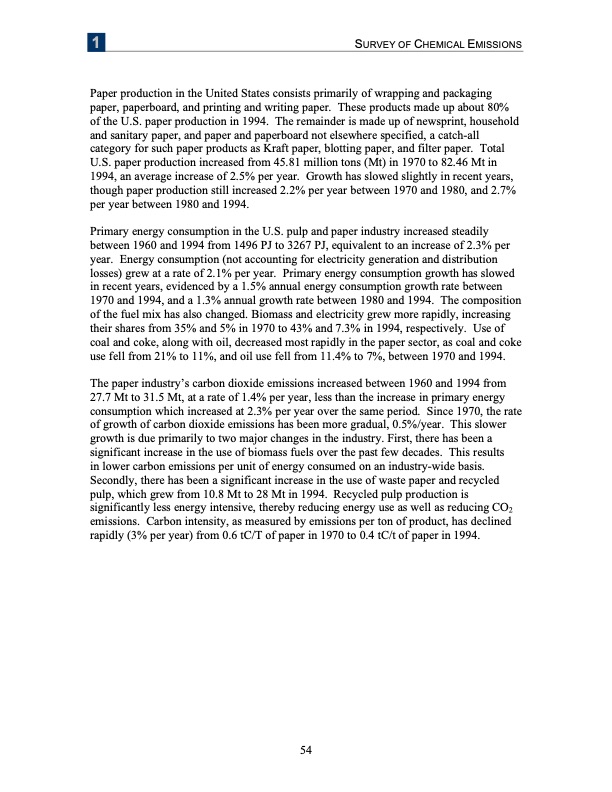
PDF Publication Title:
Text from PDF Page: 062
1 SURVEY OF CHEMICAL EMISSIONS Paper production in the United States consists primarily of wrapping and packaging paper, paperboard, and printing and writing paper. These products made up about 80% of the U.S. paper production in 1994. The remainder is made up of newsprint, household and sanitary paper, and paper and paperboard not elsewhere specified, a catch-all category for such paper products as Kraft paper, blotting paper, and filter paper. Total U.S. paper production increased from 45.81 million tons (Mt) in 1970 to 82.46 Mt in 1994, an average increase of 2.5% per year. Growth has slowed slightly in recent years, though paper production still increased 2.2% per year between 1970 and 1980, and 2.7% per year between 1980 and 1994. Primary energy consumption in the U.S. pulp and paper industry increased steadily between 1960 and 1994 from 1496 PJ to 3267 PJ, equivalent to an increase of 2.3% per year. Energy consumption (not accounting for electricity generation and distribution losses) grew at a rate of 2.1% per year. Primary energy consumption growth has slowed in recent years, evidenced by a 1.5% annual energy consumption growth rate between 1970 and 1994, and a 1.3% annual growth rate between 1980 and 1994. The composition of the fuel mix has also changed. Biomass and electricity grew more rapidly, increasing their shares from 35% and 5% in 1970 to 43% and 7.3% in 1994, respectively. Use of coal and coke, along with oil, decreased most rapidly in the paper sector, as coal and coke use fell from 21% to 11%, and oil use fell from 11.4% to 7%, between 1970 and 1994. The paper industry’s carbon dioxide emissions increased between 1960 and 1994 from 27.7 Mt to 31.5 Mt, at a rate of 1.4% per year, less than the increase in primary energy consumption which increased at 2.3% per year over the same period. Since 1970, the rate of growth of carbon dioxide emissions has been more gradual, 0.5%/year. This slower growth is due primarily to two major changes in the industry. First, there has been a significant increase in the use of biomass fuels over the past few decades. This results in lower carbon emissions per unit of energy consumed on an industry-wide basis. Secondly, there has been a significant increase in the use of waste paper and recycled pulp, which grew from 10.8 Mt to 28 Mt in 1994. Recycled pulp production is significantly less energy intensive, thereby reducing energy use as well as reducing CO2 emissions. Carbon intensity, as measured by emissions per ton of product, has declined rapidly (3% per year) from 0.6 tC/T of paper in 1970 to 0.4 tC/t of paper in 1994. 54PDF Image | Analysis for Recovering Energy from Industrial Waste Heat

PDF Search Title:
Analysis for Recovering Energy from Industrial Waste HeatOriginal File Name Searched:
PNNL_15803.pdfDIY PDF Search: Google It | Yahoo | Bing
NFT (Non Fungible Token): Buy our tech, design, development or system NFT and become part of our tech NFT network... More Info
IT XR Project Redstone NFT Available for Sale: NFT for high tech turbine design with one part 3D printed counter-rotating energy turbine. Be part of the future with this NFT. Can be bought and sold but only one design NFT exists. Royalties go to the developer (Infinity) to keep enhancing design and applications... More Info
Infinity Turbine IT XR Project Redstone Design: NFT for sale... NFT for high tech turbine design with one part 3D printed counter-rotating energy turbine. Includes all rights to this turbine design, including license for Fluid Handling Block I and II for the turbine assembly and housing. The NFT includes the blueprints (cad/cam), revenue streams, and all future development of the IT XR Project Redstone... More Info
Infinity Turbine ROT Radial Outflow Turbine 24 Design and Worldwide Rights: NFT for sale... NFT for the ROT 24 energy turbine. Be part of the future with this NFT. This design can be bought and sold but only one design NFT exists. You may manufacture the unit, or get the revenues from its sale from Infinity Turbine. Royalties go to the developer (Infinity) to keep enhancing design and applications... More Info
Infinity Supercritical CO2 10 Liter Extractor Design and Worldwide Rights: The Infinity Supercritical 10L CO2 extractor is for botanical oil extraction, which is rich in terpenes and can produce shelf ready full spectrum oil. With over 5 years of development, this industry leader mature extractor machine has been sold since 2015 and is part of many profitable businesses. The process can also be used for electrowinning, e-waste recycling, and lithium battery recycling, gold mining electronic wastes, precious metals. CO2 can also be used in a reverse fuel cell with nafion to make a gas-to-liquids fuel, such as methanol, ethanol and butanol or ethylene. Supercritical CO2 has also been used for treating nafion to make it more effective catalyst. This NFT is for the purchase of worldwide rights which includes the design. More Info
NFT (Non Fungible Token): Buy our tech, design, development or system NFT and become part of our tech NFT network... More Info
Infinity Turbine Products: Special for this month, any plans are $10,000 for complete Cad/Cam blueprints. License is for one build. Try before you buy a production license. May pay by Bitcoin or other Crypto. Products Page... More Info
| CONTACT TEL: 608-238-6001 Email: greg@infinityturbine.com | RSS | AMP |